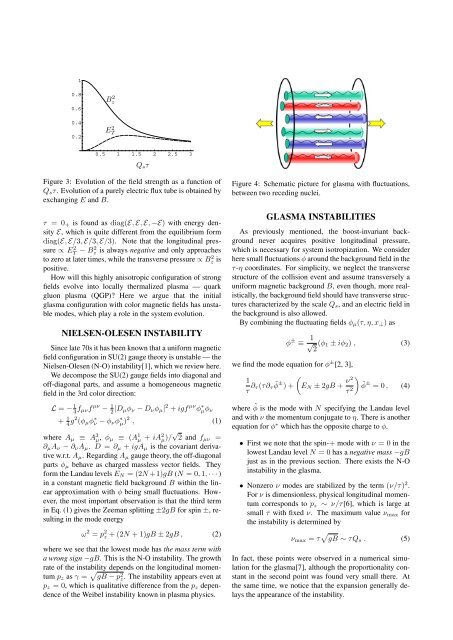Proceedings of International Conference on Physics in ... - KEK
Proceedings of International Conference on Physics in ... - KEK
Proceedings of International Conference on Physics in ... - KEK
You also want an ePaper? Increase the reach of your titles
YUMPU automatically turns print PDFs into web optimized ePapers that Google loves.
1<br />
0.8<br />
0.6<br />
0.4<br />
0.2<br />
B 2 z<br />
E 2 T<br />
0.5 1 1.5 2 2.5 3<br />
Qsτ<br />
Figure 3: Evoluti<strong>on</strong> <str<strong>on</strong>g>of</str<strong>on</strong>g> the field strength as a functi<strong>on</strong> <str<strong>on</strong>g>of</str<strong>on</strong>g><br />
Qsτ. Evoluti<strong>on</strong> <str<strong>on</strong>g>of</str<strong>on</strong>g> a purely electric flux tube is obta<strong>in</strong>ed by<br />
exchang<strong>in</strong>g E and B.<br />
τ = 0+ is found as diag(E, E, E, −E) with energy density<br />
E, which is quite different from the equilibrium form<br />
diag(E, E/3, E/3, E/3). Note that the l<strong>on</strong>gitud<strong>in</strong>al pressure<br />
∝ E 2 T − B2 z is always negative and <strong>on</strong>ly approaches<br />
to zero at later times, while the transverse pressure ∝ B 2 z is<br />
positive.<br />
How will this highly anisotropic c<strong>on</strong>figurati<strong>on</strong> <str<strong>on</strong>g>of</str<strong>on</strong>g> str<strong>on</strong>g<br />
fields evolve <strong>in</strong>to locally thermalized plasma — quark<br />
glu<strong>on</strong> plasma (QGP)? Here we argue that the <strong>in</strong>itial<br />
glasma c<strong>on</strong>figurati<strong>on</strong> with color magnetic fields has unstable<br />
modes, which play a role <strong>in</strong> the system evoluti<strong>on</strong>.<br />
NIELSEN-OLESEN INSTABILITY<br />
S<strong>in</strong>ce late 70s it has been known that a uniform magnetic<br />
field c<strong>on</strong>figurati<strong>on</strong> <strong>in</strong> SU(2) gauge theory is unstable — the<br />
Nielsen-Olesen (N-O) <strong>in</strong>stability[1], which we review here.<br />
We decompose the SU(2) gauge fields <strong>in</strong>to diag<strong>on</strong>al and<br />
<str<strong>on</strong>g>of</str<strong>on</strong>g>f-diag<strong>on</strong>al parts, and assume a homogeneous magnetic<br />
field <strong>in</strong> the 3rd color directi<strong>on</strong>:<br />
L = − 1<br />
4 fµνf µν − 1<br />
2 |Dµφν − Dνφµ| 2 + igf µν φ ∗ µφν<br />
+ 1<br />
4 g2 (φµφ ∗ ν − φνφ ∗ µ) 2 , (1)<br />
where Aµ ≡ A 3 µ, φµ ≡ (A 1 µ + iA 2 µ)/ √ 2 and fµν =<br />
∂µAν − ∂νAµ. D = ∂µ + igAµ is the covariant derivative<br />
w.r.t. Aµ. Regard<strong>in</strong>g Aµ gauge theory, the <str<strong>on</strong>g>of</str<strong>on</strong>g>f-diag<strong>on</strong>al<br />
parts φµ behave as charged massless vector fields. They<br />
form the Landau levels EN = (2N +1)gB (N = 0, 1, · · · )<br />
<strong>in</strong> a c<strong>on</strong>stant magnetic field background B with<strong>in</strong> the l<strong>in</strong>ear<br />
approximati<strong>on</strong> with φ be<strong>in</strong>g small fluctuati<strong>on</strong>s. However,<br />
the most important observati<strong>on</strong> is that the third term<br />
<strong>in</strong> Eq. (1) gives the Zeeman splitt<strong>in</strong>g ±2gB for sp<strong>in</strong> ±, result<strong>in</strong>g<br />
<strong>in</strong> the mode energy<br />
ω 2 = p 2 z + (2N + 1)gB ± 2gB , (2)<br />
where we see that the lowest mode has the mass term with<br />
a wr<strong>on</strong>g sign −gB. This is the N-O <strong>in</strong>stability. The growth<br />
rate <str<strong>on</strong>g>of</str<strong>on</strong>g> the <strong>in</strong>stability depends <strong>on</strong> the l<strong>on</strong>gitud<strong>in</strong>al momentum<br />
pz as γ = √ gB − p 2 z. The <strong>in</strong>stability appears even at<br />
pz = 0, which is qualitative difference from the pz dependence<br />
<str<strong>on</strong>g>of</str<strong>on</strong>g> the Weibel <strong>in</strong>stability known <strong>in</strong> plasma physics.<br />
Figure 4: Schematic picture for glasma with fluctuati<strong>on</strong>s,<br />
between two reced<strong>in</strong>g nuclei.<br />
GLASMA INSTABILITIES<br />
As previously menti<strong>on</strong>ed, the boost-<strong>in</strong>variant background<br />
never acquires positive l<strong>on</strong>gitud<strong>in</strong>al pressure,<br />
which is necessary for system isotropizati<strong>on</strong>. We c<strong>on</strong>sider<br />
here small fluctuati<strong>on</strong>s φ around the background field <strong>in</strong> the<br />
τ-η coord<strong>in</strong>ates. For simplicity, we neglect the transverse<br />
structure <str<strong>on</strong>g>of</str<strong>on</strong>g> the collisi<strong>on</strong> event and assume transversely a<br />
uniform magnetic background B, even though, more realistically,<br />
the background field should have transverse structures<br />
characterized by the scale Qs, and an electric field <strong>in</strong><br />
the background is also allowed.<br />
By comb<strong>in</strong><strong>in</strong>g the fluctuat<strong>in</strong>g fields φµ(τ, η, x⊥) as<br />
φ ± ≡ 1<br />
√ 2 (φ1 ± iφ2) , (3)<br />
we f<strong>in</strong>d the mode equati<strong>on</strong> for φ ± [2, 3],<br />
(<br />
)<br />
˜φ ± = 0 , (4)<br />
1<br />
τ ∂τ (τ∂τ ˜ φ ± ) +<br />
EN ± 2gB + ν2<br />
τ 2<br />
where ˜ φ is the mode with N specify<strong>in</strong>g the Landau level<br />
and with ν the momentum c<strong>on</strong>jugate to η. There is another<br />
equati<strong>on</strong> for φ ∗ which has the opposite charge to φ.<br />
• First we note that the sp<strong>in</strong>-+ mode with ν = 0 <strong>in</strong> the<br />
lowest Landau level N = 0 has a negative mass −gB<br />
just as <strong>in</strong> the previous secti<strong>on</strong>. There exists the N-O<br />
<strong>in</strong>stability <strong>in</strong> the glasma.<br />
• N<strong>on</strong>zero ν modes are stabilized by the term (ν/τ) 2 .<br />
For ν is dimensi<strong>on</strong>less, physical l<strong>on</strong>gitud<strong>in</strong>al momentum<br />
corresp<strong>on</strong>ds to pz ∼ ν/τ[6], which is large at<br />
small τ with fixed ν. The maximum value νmax for<br />
the <strong>in</strong>stability is determ<strong>in</strong>ed by<br />
νmax = τ √ gB ∼ τQs . (5)<br />
In fact, these po<strong>in</strong>ts were observed <strong>in</strong> a numerical simulati<strong>on</strong><br />
for the glasma[7], although the proporti<strong>on</strong>ality c<strong>on</strong>stant<br />
<strong>in</strong> the sec<strong>on</strong>d po<strong>in</strong>t was found very small there. At<br />
the same time, we notice that the expansi<strong>on</strong> generally delays<br />
the appearance <str<strong>on</strong>g>of</str<strong>on</strong>g> the <strong>in</strong>stability.













